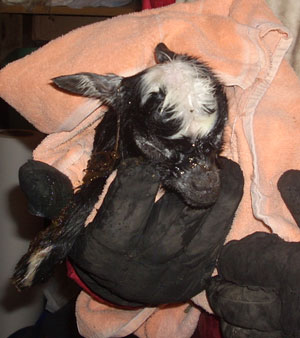Goat Birthing -
The Essentials
Goat birthing is a natural part of having a dairy goat. If your doe doesn't have babies, she won't produce milk. Therefore, you have to expect her to "get in the family way" at least once a year if you want to have a continuing supply of milk for you and your family.

The good news is the experience doesn't have to be frightening or overwhelming.
Many times I have gone out to feed my goats and was surprised with a new addition, so I didn't have to do anything at all.
Still, in case of problems, it's wise to be prepared. And with a few supplies and a little preparation, the miracle of birth can be both positive and exhilarating.

What's the gestation period for a goat?
On average, the gestation period from conception to goat birthing is 145 to 155 days or a little over five months. A doe pregnant with twins or triplets (and this happens quite frequently with goats) will go into labor a little earlier than a doe pregnant with only one goatling.
So you need to start checking your doe every day about 140 days after she has been bred. When she is close to giving birth, she will become restless and nip at her sides. Also, her flanks will hollow and the tail bone on the top of her back will ridge up and feel slack. She may also have a small discharge from her vulva.
Supplies You Absolutely Have To Have
• Iodine
• A roll of paper towels or several clean cloth towels
You'll need iodine in a small container. Dip the kid's umbilical cord all the way up to the navel in the iodine to prevent infection. Then cover its entire abdomen with iodine.
The towels are for cleaning off the newborn.
Useful Supplies for Goat Birthing
• Feeding tube and syringe
• Lamb nipples
• A soda or wine bottle
• Alfalfa hay
• Warm, drinking water
• Frozen colostrom or a colostrom substitute
After Your Doe Has Gone Into Labor
Take away any water buckets that are near your doe. There's a risk that as she drops her kid during goat birthing, it may fall into the water and drown. Your doe will strain with greater strength and frequency.
Eventually a membrane bag will come out of her vagina. You should be able to see two hooves and then the tip of a nose. Soon after this, the head and hooves will be pushed out, and then the rest of the little guy will slide out.
This is where those clean towels come in handy. Wipe baby down vigorously, taking care to wipe its nose and mouth, removing any mucus so the goatling can breathe. In case your doe is kidding twins, pick up the newborn so that she doesn't sit on it while delivering the next one.
Dip the goatling's umbilical cord in iodine and put the newborn into a box until mom is done.
If Your Doe is Having Problems
She could be having a breech birth, which means the kid isn't in the correct position. This is more common when the doe is kidding twins or triplets. If your doe has been struggling for awhile, and there is still no baby, scrub your hand and lubricate it with mineral oil or K-Y jelly.
Hold your fingers in a cone position and push them gently into the birth canal. Bring down first one leg and then the other. Pull very gently; if you pull too hard, you may cause a hemorrhage.
Reward Your Doe After Goat Birthing
Give your goat warm water even if she has given birth in the middle of summer. A doe who has just given birth loses a lot of heat and will appreciate the warmth. Then offer her the alfalfa hay and a treat of raisins. She's had a tough day!
Learn more about how to raise goats by clicking here.










New! Comments
Have your say about what you just read! Leave me a comment in the box below.